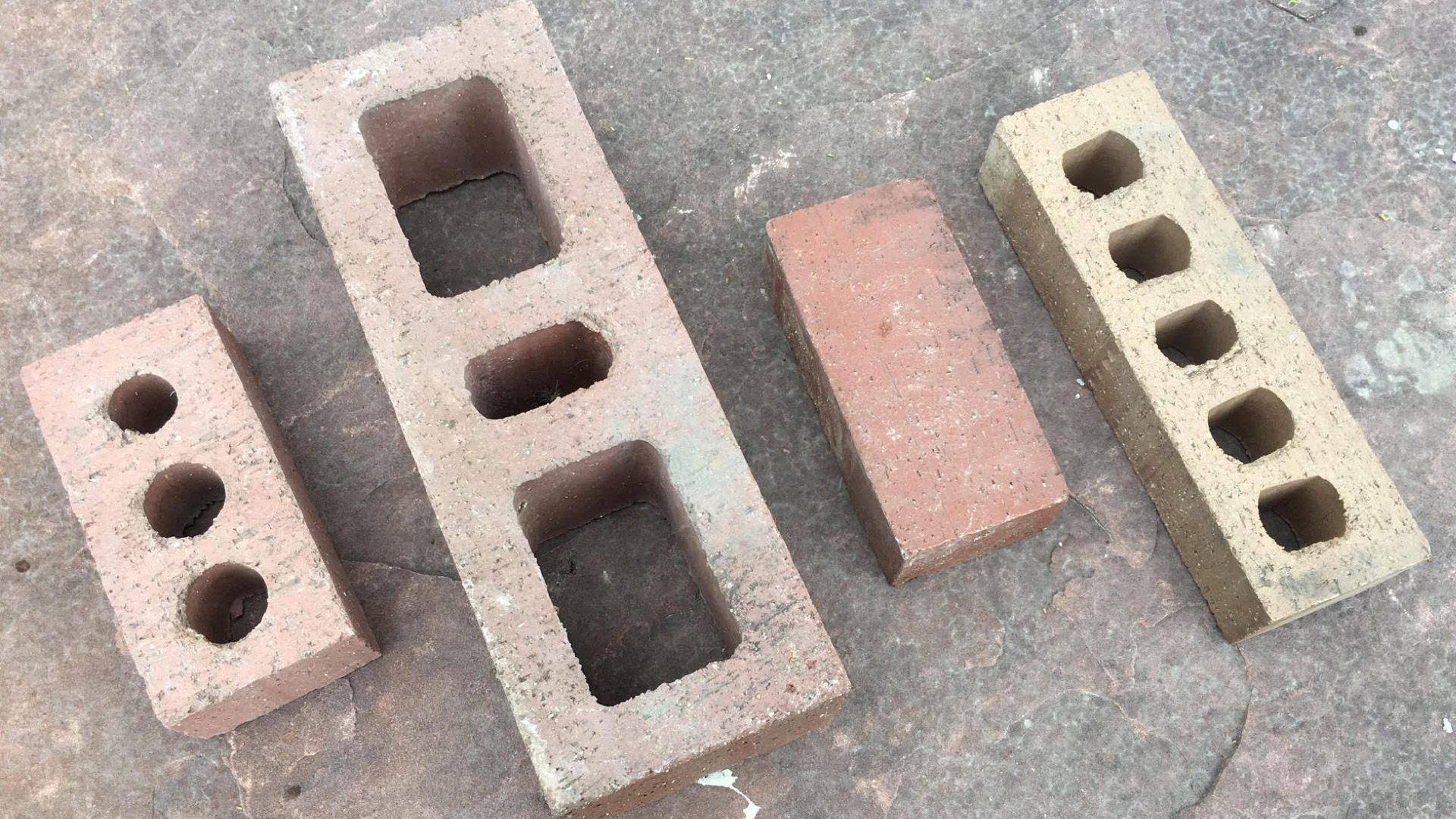Brick: ASTM Standards for Brick
Words: Margaret Foster
From left: face brick, hollow brick, paving brick, building brick.
A brick is a brick, right? Well, not really, in the eyes of the standards organization, ASTM International. Separate ASTM standards exist for building brick, facing brick, hollow brick, paving brick, firebox brick, sewer and manhole brick, and others. This short article is intended to provide an overview and roadmap of the various ASTM standards related to typical clay masonry units or “bricks”.
Building brick, covered under ASTM C62, Standard Specification for Building Brick (Solid Masonry Units Made from Clay or Shale), are intended to be used as a veneer or structural brickwork where appearance is not critical. Building brick have several grades depending on their resistance to damage from freezing when saturated. In order of durability, the grades are: Severe Weathering (Grade SW), Moderate Weathering (Grade MW), or Negligible Weathering (Grade NW). Weathering grades are typically determined by the compressive strength of the units, the 24-hour cold water absorption, the 5-hour boiling water absorption and the ratio of the 24-hour to 5-hour results. Consult the map in ASTM C62 or C216 if you are unsure which grade is appropriate for your geographic area.
Facing brick are units that can be used in structural or veneer applications, but where the aesthetic appearance is more important. ASTM C216, Standard Specification for Facing Brick (Solid Masonry Units Made from Clay or Shale), contains the physical requirements for facing brick. Because of the increased importance on appearance, ASTM C216 does not cover Grade NW units and adds three types of facing brick: Type FBS, for general use, Type FBX, for units with tighter dimensional tolerances, and Type FBA, for brickwork intended to produce an architectural effect using more variation in size and texture of the units.
ASTM Standard C652, Standard Specification for Hollow Brick (Hollow Masonry Units Made from Clay or Shale), covers units where the net bedded area (after subtracting out cores, cells or deep frogs) is less than 75% of the gross area. Hollow brick can be used similar to building or facing brick in either structural brickwork or veneer applications. Some hollow brick have large enough cores that the brickwork can be reinforced and grouted in structural brickwork. Hollow brick is either Grade SW or MW and, similar to facing brick, have several defined types: Type HBS, for general use, Type HBX, with tighter dimensional tolerances, Type HBA, with variations in size or texture to produce an architectural effect, and Type HBB, where variations in color, texture, dimensions, and other visible imperfections are not a consideration. This standard also covers two classes of hollow brick depending on the ratio of the net vs. gross bedded area. Class H40V hollow brick have a voided area greater than 25%, but not more than 40% of the gross cross-sectional area. Class H60V are hollow brick with a void ratio greater than 40% but less than 60% of the gross cross-sectional area.
Thin brick have their own specification, ASTM C1088, Standard Specification for Thin Veneer Brick Units Made From Clay or Shale, which instead of weathering grades, differentiates grades as Exterior or Interior. Physical requirements for Grade Exterior are similar to Grade SW and Grade Interior requirements are similar to Grade MW except that there is no minimum requirement for compressive strength.
There are two ASTM standards for paving brick depending on the severity of the anticipated loading. These are: ASTM C902, Standard Specification for Pedestrian and Light Traffic Paving Brick and ASTM C1272, Standard Specification for Heavy Vehicular Paving Brick.
Standard C902 defines weathering classes as: Class SX, brick intended for use where it may be frozen while saturated, Class MX, where freeze/thaw resistance is not a consideration, and Class NX, for interior use protected from freezing while saturated. Abrasion resistance is a consideration included in C902 and defines several types, in decreasing order of abrasion resistance, as: Type I, Type II and Type III. Like other brick standards, ASTM C902 defines three tolerance categories as: Application PS, for brick intended for general use without mortar joints or with mortar joints laid in bond patterns where dimensional tolerances are not critical, Application PX, without mortar joints and where tight dimensional tolerances are required, and Application PA, where variations in size, texture or color are used for architectural effect.
Heavy vehicular paving brick, covered under ASTM C1272, have two types, Type R, intended to be set in mortar over a concrete base or set in asphalt over an asphalt or concrete base, and Type F, intended to be set in sand with sand joint over any adequate base. Applications are: Application PS, for general use, Application PX where tighter dimensional tolerances are required, and Application PA where the variation in size color or texture are used to convey an architectural effect.
So, we can see that ASTM International has many standards to cover “bricks” depending on their intended purpose, required weather resistance, dimensional tolerances and aesthetic and other considerations. Some clay masonry units may be able to meet the requirements of several standards, while some units (e.g. thin brick) fall under a single specific ASTM standard. In the eyes of ASTM standard specifications, all bricks are not created equal.